
Canadian International School (CIS) is an authorised International Baccalaureate (IB) World School that has two campuses in Singapore.
To get parents to consider enrolling their child in the school, CIS needed to get parents to sign up for their open house or make an inquiry.
Previously, they were working with a very small budget and their ad campaign only targeted the audiences in Singapore.
As they expanded their programmes, they decided to target a larger audience – both in Singapore and from neighbouring countries.
As they were unsure of how to scale up their campaign without breaking the bank, they decided to engage us to implement a strategy that ensured that CIS was top-of-mind when parents were doing their search for international schools to enroll their child in.
Here are the main KPIs that were set for their ad campaign
- Low Cost Per Acquisition
- High Lead Conversions
- Increased Web Traffic
- Healthy Bounce Rate
Before we started on the campaign, we did an audit to uncover the underlying problems
Firstly, we found that their Google ads only had a single-headline with a double-description, which was the old format for ads.
Instead of continuing with this format, we used Expanded Text Ads on Google, which has a double-headline, single-description arrangement.
Before*
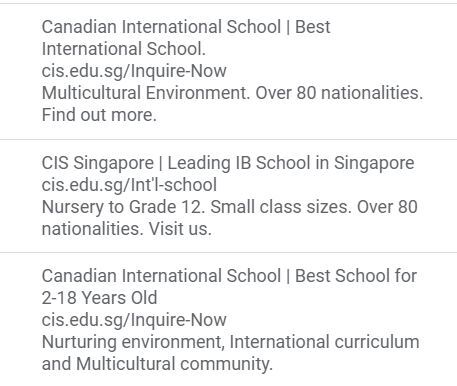
After
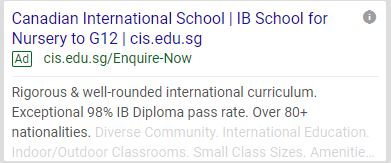
*for illustration only - the ‘before’ ads (not done by us) do not have the same ad copy as our ‘after’ ad.
The expanded text ad is shown above – it gives the audience more information about CIS at a glance as the headline stands out and maxmises visibility of the ad.
With better visibility, the target audience can get the information that they want more quickly and decide whether or not CIS can meet their needs. This creates better qualified leads as it helps to reduce the bounce rate.
For example, if the parent has a child who has already progressed past G12, he/she would not click on the ‘after’ ad, while he/she might unknowingly click on the ‘before’ ad, not find what they need, and exit the page abruptly.
We did not want this to happen because
- the money from that click-through is wasted and
- it contributes to the bounce rate, which we want to reduce as much as possible.
Next, we went through the keywords that they were bidding for and found that they were using broad match, a keyword match type that allows their ad to match the widest range of possible keyword searches that are related to the keyword.
To avoid spending on underperforming keywords, we added negative keywords so that their ad would not show up for these underperforming keywords.
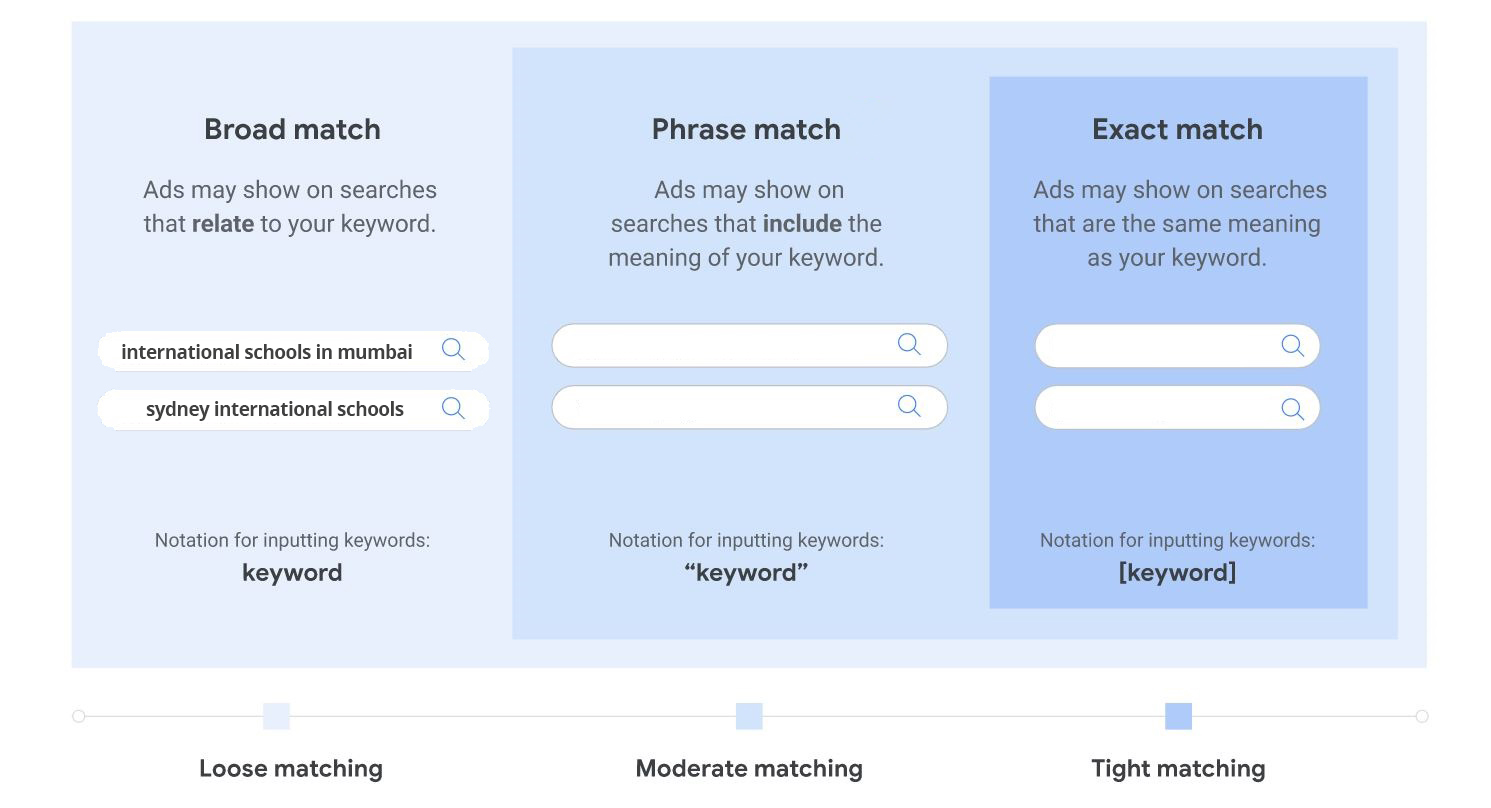
Although broad match allowed them to reach a wider audience, the keywords from this were numerous and very varied.
These keywords were not sorted properly, making it difficult for them to evaluate which keywords were performing and which ones were not.
Hence, we sorted the keywords into groups. Through this process, we discovered that a few of their keywords were extremely expensive and did not bring in the number of conversions that justified the high expenditure.
The money saved from this would be channeled into keywords that were actually converting.
As the campaign progressed, Google generated data on how our keyword bids and ads were performing. We looked at the best performing keywords and ads and used this data to fine-tune our bidding strategy so that the results would be even better.
One thing that we adjusted in our bidding strategy was to change from ‘Enhanced CPC’ to ‘Target CPA’. Although both strategies have their benefits, changing to ‘Target CPA’ allowed us to better manage the set budget in line with the CPA goals, which is great for lead generation.
This was effective in lowering the CPA, which is one of the main KPIs for this campaign.
Another thing that we adjusted was the target criteria for ‘international school’ keywords. Instead of “people in your target location or who show interest in your target location”, we changed it to “people in your target location”.
This ensured maximum visibility of the ads for parents who were not located in Singapore who were gathering information on international schools.
For example, a parent who is located in Thailand might be exploring international schools in the Southeast Asia region, but did not specifically show interest in Singapore yet. With the first target criteria, they would not be aware of CIS as the ads do not show up.
However, with the second target criteria, CIS ads show up. To avoid overspending on parents at this discovery stage, we lowered the bid by 20% for these ‘international school’ keywords.
As part of our strategy, we used Google Display Network (GDN) to remarket CIS to parents who had previously visited CIS’ website but didn’t convert immediately.

Using a targeted message on websites that they frequent, draws them back helps CIS stay top of mind. This increases the likelihood that these indecisive parents will convert at a later date.
CIS was concerned about the additional cost incurred running ads on GDN. They did not want to spend money on GDN and told us to pause it.
However, this impacted the CPA on the search campaign. Without remarketing efforts from GDN, the CPA increased, which was not in line with their main KPI of low CPA.
One challenge that we faced was that CIS had many programmes and a wealth of information to offer parents who were searching for an international school. However, it was almost impossible to include all the benefits of their programmes without experiencing an information overload.
To identify their key selling points, we did some research on our end.
We found a compelling video of an African child speaking fluent Mandarin on YouTube. This video was part of CIS’ brand assets and was very persuasive.
Hence, we sought their approval to use this video in our Facebook ads.
As compelling video ads drive a lot of engagement with the target audience, it promoted their bilingual programmes in a powerful way.
Besides using the angle of bilingualism, we also explored other angles. As the campaign ran, we created more ads in line with the angles which were performing the best in order to further optimise the ad spend.
Besides optimising the ad spend, we also optimised the landing page for CIS. Previously, CIS’ ads led to their homepage on their website, instead of a dedicated landing page.
This affected the conversions because their homepage had many buttons for the audience to navigate away from. There was a higher chance of them getting distracted and not performing the action that we wanted them to, namely, to sign up for the open house.
In addition, we also made sure that information on their school tours were readable. Long paragraphs of text on a small mobile screen would discourage parents from reading about the tour and its availability.
Before
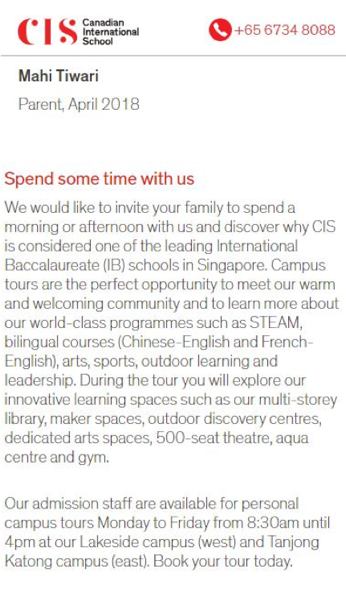
After
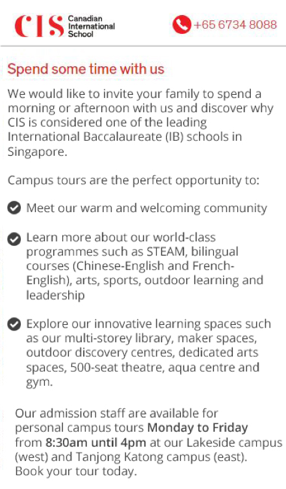
As a result of our efforts, we reduced the cost per lead by 34% for CIS, and generated 442 leads.
CIS was very pleased about the results and commended us on our work.
Watch the testimonial video to see what Sheena King, the Marketing Manager of CIS, said about our work.